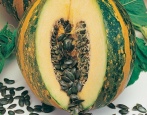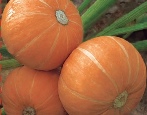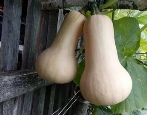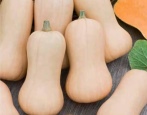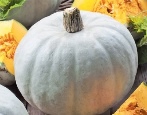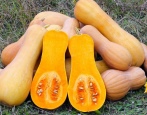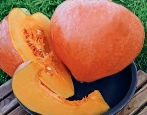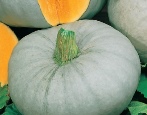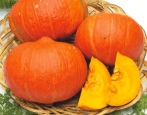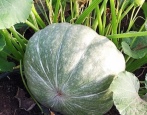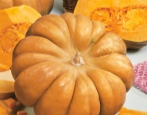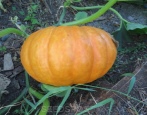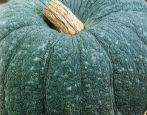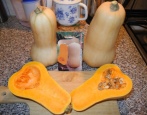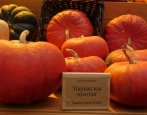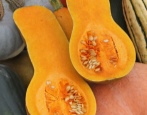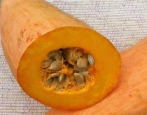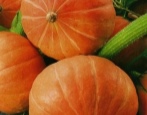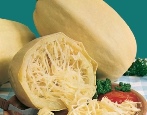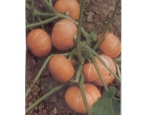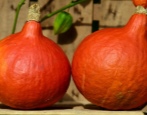
- Authors: Kushnereva V.P., Khimich G.A., Zharova V.P.
- Year of approval: 1998
- Lash length, m: up to 1
- Leaf shape: reniform
- Leaf color: light green, with yellow mosaic
- The form: spherical, slightly flattened
- Weight, kg: 0,7-1,0
- Coloration: background bright orange, pattern with slightly visible white stripes
- Bark: medium, leathery
- Color of the pulp: bright orange
Thanks to the fruitful work of breeders, it became possible to grow a pumpkin even in a short and cool summer. The early-ripening pumpkin variety “Smile” of Russian selection is quickly adapting to climatic conditions, unpretentious, and also very productive.
Breeding history
Pumpkin culture Smile is a relatively new variety that appeared thanks to a group of scientists from the Federal Research Center of Vegetable Growing in 1996. The authorship belongs to the well-known breeders Kushnereva V.P., Zharova V.P. and Khimich G.A. You can grow pumpkin in almost any climatic zone.
Description of the variety
Pumpkin Smile is a compact bush-type plant that forms about 6 shortened shoots. It does not grow very much, which allows vegetable crops in the neighborhood to grow comfortably. The plant is characterized by short lashes (the maximum length of the central lash reaches 100 cm), large kidney-shaped leaves endowed with a uniform light green cover with a pronounced yellow mosaic, as well as a fragile root system.
During the flowering period, large flowers of a rich yellow or orange color appear on pumpkin bushes, emitting an incredibly pleasant aroma. On a healthy bush, about 7 fruits ripen, but on some plants up to 10 pumpkin specimens can be present. Fruit formation takes place near the stem.
Characteristics of the appearance of plants and fruits
Pumpkin belongs to the large-fruited class. Specimens grow up weighing 700-1000 grams. The pumpkin has a spherical shape, sometimes there are specimens with a noticeable flattening. The surface of the fruit is smooth, with pronounced light stripes. The medium density peel is characterized by firmness and a bright orange color. The seed nest of the variety is small, and white oval seeds are contained in small quantities.
Thanks to its strong peel, the harvested crop can easily be transported over long distances, and also demonstrates long-term keeping quality - up to 6-7 months. It is characteristic that during storage the palatability of pumpkin only improves.
Purpose and taste
In addition to its commercial appeal, pumpkin is endowed with a great taste. The bright orange pulp has a fleshy, crunchy, dense and slightly juicy texture. The fruit has a balanced taste: sweet, with pleasant fruity notes and a summer aroma. Many growers note the melon flavor in this pumpkin variety.
The harvested crop can be widely used in cooking: pumpkin is suitable for cooking cereals, vegetable stews, soups. In addition, pumpkin can be baked, prepared for filling for pies, and it is also included in the diet and children's menu due to its low calorie content. The only thing this pumpkin variety is not suitable for is juicing.
Ripening terms
Smile is an early ripening variety. From the emergence of mass shoots to harvesting vegetables from the garden, less than 3 months pass - 85 days. The pumpkin is removed along with the stalks as it ripens, very carefully so as not to damage the integrity.It is not recommended to keep the fruits on the ridge until the maximum ripening, as this can inhibit the growth of the following specimens. Harvesting begins in August and proceeds gradually as the pumpkin fruit ripens.
Yield
The variety stands out among its congeners for its high productivity. Yield indicators do not depend on weather conditions. On average, 3-5 kg of delicious specimens can be collected from 1 m2 of plantings. On an industrial scale, yields are also high - 280-295 centners / ha of plantings.
Growing and care
Pumpkin is cultivated in two ways: seed (in southern and warmer regions) and seedling (in regions with a cold climate). When planting a vegetable with seeds, some recommendations should be followed: full-weight seeds without damage are selected, processed with a growth stimulator. Planting is carried out in late May or early June, when the soil is warmed up to + 11-12 degrees to a depth of 8-10 cm. Usually 2 seeds are placed in each hole.
Sowing seeds for seedlings is carried out in April. Better to plant in peat pots, from which it is easy to extract plants with fragile roots. After 3 weeks, the matured bushes, which have shortened internodes and have 3-4 true leaves, are transferred to open ground. This is carried out in late May - early June, when the temperature regime has stabilized. Planting is carried out to a depth of 5 cm. The recommended scheme for planting is 60x60 cm. At the end of the procedure, the beds with plantings are watered abundantly with warm water. If there is a threat of recurrent night frosts, you need to cover the sprouts or bushes of seedlings with any suitable material, a plastic bottle.
The pumpkin farming technique is standard. A vegetable crop needs regular irrigation (each bush requires 2-3 liters of water), which stop 3 weeks before harvesting, a single feeding with organic fertilizers, the formation of a bush (pinching the main whip), thinning, if two plants grow from the hole, weeding and loosening the soil, preventing viruses and insect attacks.
In addition, many farmers recommend mulching using straw, sawdust or hay, which will prevent the rapid growth of weeds, as well as retain moisture. Some growers advise thinning the foliage, which will open up light access to all parts of the bush. As a rule, 4-6 leaves are kept on a pumpkin bush.
Requirements for soil and climatic conditions
Pumpkin Smile is cold-resistant, so it easily tolerates night frosts, sharp temperature fluctuations. In addition, the culture is resistant to short-term drought and heat. Despite this, planting should be planned in the southern part of the site, where there is abundant sun, warmth, light, and there is also a reliable barrier from gusty winds and drafts.
Suitable for planting are light, nutritious and breathable soils with neutral acidity. Optimal for pumpkin are sandy loam, light loamy fertile soils saturated with organic matter.
Disease and pest resistance
The variety is characterized by strong immunity, therefore it is resistant to many fungal infections (powdery mildew, bacteriosis, peronosporosis, anthracnose) and pests (wireworm, melon aphid, spider mite). Violation of agricultural technology or excessive dampness, in which rot can develop, can contribute to the appearance of diseases. So that the fruits do not rot when in contact with the ground, it is necessary to put small planks under them.
